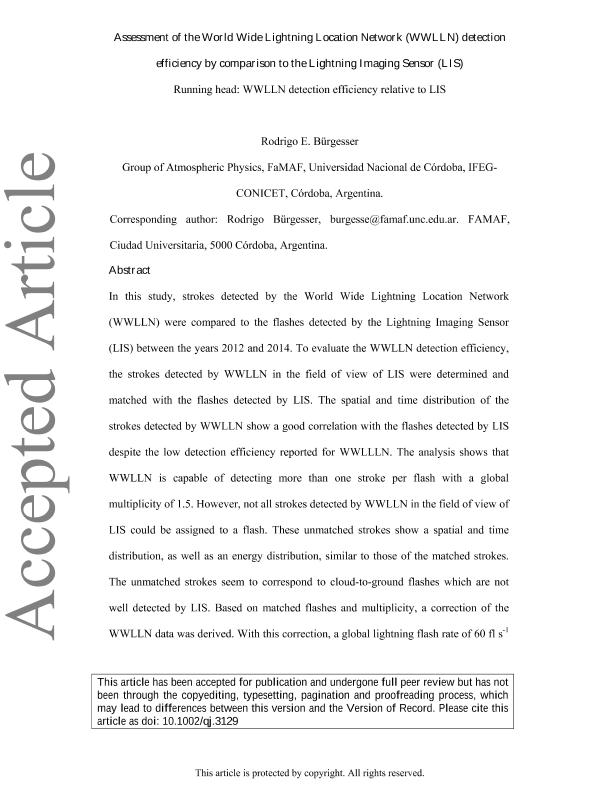Mostrar el registro sencillo del ítem
dc.contributor.author
Burgesser, Rodrigo Exequiel

dc.date.available
2018-11-16T17:18:06Z
dc.date.issued
2017-10
dc.identifier.citation
Burgesser, Rodrigo Exequiel; Assessment of the World Wide Lightning Location Network (WWLLN) detection efficiency by comparison to the Lightning Imaging Sensor (LIS); John Wiley & Sons Ltd; Quarterly Journal of the Royal Meteorological Society; 143; 708; 10-2017; 2809-2817
dc.identifier.issn
0035-9009
dc.identifier.uri
http://hdl.handle.net/11336/64617
dc.description.abstract
In this study, strokes detected by the World Wide Lightning Location Network (WWLLN) were compared to the flashes detected by the Lightning Imaging Sensor (LIS) between the years 2012 and 2014. To evaluate the WWLLN detection efficiency, the strokes detected by WWLLN in the field of view of LIS were determined and matched with the flashes detected by LIS. The spatial and time distribution of the strokes detected by WWLLN show a good correlation with the flashes detected by LIS despite the low detection efficiency reported for WWLLLN. The analysis shows that WWLLN is capable of detecting more than one stroke per flash with a global multiplicity of 1.5. However, not all strokes detected by WWLLN in the field of view of LIS could be assigned to a flash. These unmatched strokes show a spatial and time distribution, as well as an energy distribution, similar to those of the matched strokes. The unmatched strokes seem to correspond to cloud-to-ground flashes which are not well detected by LIS. Based on matched flashes and multiplicity, a correction of the WWLLN data was derived. With this correction, a global lightning flash rate of 60 fl s-1 was obtained and a map of the corrected flash density detected by WWLLN was performed. The spatial distribution of WWLLN multiplicity and detection probability are available for the community.
dc.format
application/pdf
dc.language.iso
eng
dc.publisher
John Wiley & Sons Ltd

dc.rights
info:eu-repo/semantics/openAccess
dc.rights.uri
https://creativecommons.org/licenses/by-nc-sa/2.5/ar/
dc.subject
Detection Efficiency
dc.subject
Lightning
dc.subject
Lis
dc.subject
Wwlln
dc.subject.classification
Meteorología y Ciencias Atmosféricas

dc.subject.classification
Ciencias de la Tierra y relacionadas con el Medio Ambiente

dc.subject.classification
CIENCIAS NATURALES Y EXACTAS

dc.title
Assessment of the World Wide Lightning Location Network (WWLLN) detection efficiency by comparison to the Lightning Imaging Sensor (LIS)
dc.type
info:eu-repo/semantics/article
dc.type
info:ar-repo/semantics/artículo
dc.type
info:eu-repo/semantics/publishedVersion
dc.date.updated
2018-10-22T18:20:57Z
dc.identifier.eissn
1477-870X
dc.journal.volume
143
dc.journal.number
708
dc.journal.pagination
2809-2817
dc.journal.pais
Reino Unido

dc.journal.ciudad
Londres
dc.description.fil
Fil: Burgesser, Rodrigo Exequiel. Consejo Nacional de Investigaciones Científicas y Técnicas. Centro Científico Tecnológico Conicet - Córdoba. Instituto de Física Enrique Gaviola. Universidad Nacional de Córdoba. Instituto de Física Enrique Gaviola; Argentina. Universidad Nacional de Córdoba. Facultad de Matemática, Astronomía y Física; Argentina
dc.journal.title
Quarterly Journal of the Royal Meteorological Society

dc.relation.alternativeid
info:eu-repo/semantics/altIdentifier/url/http://doi.wiley.com/10.1002/qj.3129
dc.relation.alternativeid
info:eu-repo/semantics/altIdentifier/doi/https://dx.doi.org/10.1002/qj.3129
Archivos asociados
